Standard [CURRENT]
ASTM D 4365:2025
Standard Test Method for Determining Micropore Volume and Zeolite Area of a Catalyst
- German title
- Bestimmung der Zeolithfläche eines Katalysators
- Publication date
- 2025
- Original language
- English
- Pages
- 7
- Publication date
- 2025
- Original language
- English
- Pages
- 7
- DOI
- https://dx.doi.org/10.1520/D4365-25
Product information on this site:
Quick delivery via download or delivery service
Buy securely with a credit card or pay upon receipt of invoice
All transactions are encrypted
Short description
1.1 This test method covers the determination of total surface area and mesopore area from N 2 adsorption. From these results are calculated the zeolite area and micropore volume of a zeolite containing catalyst. The micropore volume is related to the percent zeolite in the catalyst. The zeolite area, a number related to the surface area within the zeolite pores, may also be calculated. Zeolite area, however, is difficult to interpret in physical terms because of the manner in which nitrogen molecules pack within the zeolite. 1.2 The values stated in SI units are to be regarded as standard. No other units of measurement are included in this standard. 1.3 This standard does not purport to address all of the safety concerns, if any, associated with its use. It is the responsibility of the user of this standard to establish appropriate safety, health, and environmental practices and determine the applicability of regulatory limitations prior to use. For a specific precautionary statement, see Note 3 . 1.4 This international standard was developed in accordance with internationally recognized principles on standardization established in the Decision on Principles for the Development of International Standards, Guides and Recommendations issued by the World Trade Organization Technical Barriers to Trade (TBT) Committee.
ICS
71.040.30
DOI
https://dx.doi.org/10.1520/D4365-25
Also available in
Loading recommended items...
Loading recommended items...
Loading recommended items...

